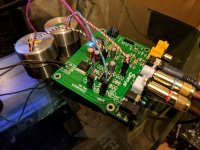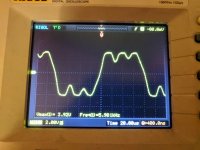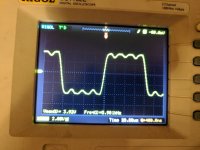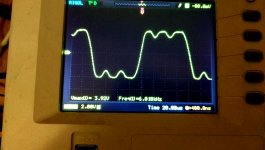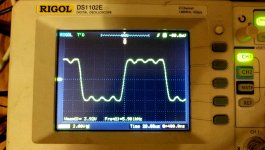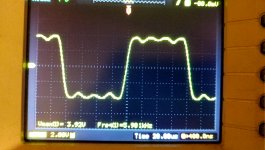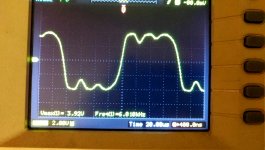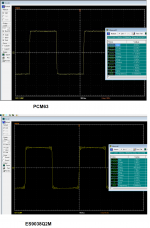Yes, photos (with labels if possible 🙂 ) just great for us less technical types !
I solder well, build power supplies and am happy to mod things if I have a recipe but having guidance from you and Markw4 is most appreciated as my circuit knowledge is limited.
I solder well, build power supplies and am happy to mod things if I have a recipe but having guidance from you and Markw4 is most appreciated as my circuit knowledge is limited.
Hi guys!
I got my 9038q2m board few days ago (VR1.06). From stock version it sounds very good, at least much better, than hifime Android ES9018 DAC. But even powered from superior quality linear PSU (+/- 15V) it still sounds like plastic, far from smoth analog lifelike music. That is why I still prefer old multibit DACs instead of modern delta-sigma.
But in frames of subject let me notice the real sound improvement phases on this board.
I don't want to say much about digital things, will indicate just for reference (should be): clean lines of IIS, clean XOs, iso, bitperfect.
However the real magic, even in modern time still happens in the analog part of DAC.
First of all, as I said above - PSU. The main PSU with clean, linear phase\impedance (without tons of ultra HFs and LPFs) is realy must to be in any DAC implementation. It is absolutely needed because the most significant part of music is located in the small signals. Small signals is a glue for anything in the world of sounds. From practice, "Virtual battery" schematic is a good choice (at least) to go down to 16 bit and deeper accuracy. When the first PSU is clean, all other regs and LDO's will do their job much better. Second step in list, but really in "the same league" with PSU quality is the i/v converion stage. I have tried a lot of different variations of i/v on OPamps (and discret) in past, but after current transformers (very low primary DC resistance of ~5-10 Ohm with enough inductane for LF), I have realy forgot about any OPs and other electronic devices in i/v stage. This DAC now is very close to my PCM63s. It is very simple to put transformers into layout of this board - just to remove a few elements and to solder instead of them pins for primary and secondary coils.
I got my 9038q2m board few days ago (VR1.06). From stock version it sounds very good, at least much better, than hifime Android ES9018 DAC. But even powered from superior quality linear PSU (+/- 15V) it still sounds like plastic, far from smoth analog lifelike music. That is why I still prefer old multibit DACs instead of modern delta-sigma.
But in frames of subject let me notice the real sound improvement phases on this board.
I don't want to say much about digital things, will indicate just for reference (should be): clean lines of IIS, clean XOs, iso, bitperfect.
However the real magic, even in modern time still happens in the analog part of DAC.
First of all, as I said above - PSU. The main PSU with clean, linear phase\impedance (without tons of ultra HFs and LPFs) is realy must to be in any DAC implementation. It is absolutely needed because the most significant part of music is located in the small signals. Small signals is a glue for anything in the world of sounds. From practice, "Virtual battery" schematic is a good choice (at least) to go down to 16 bit and deeper accuracy. When the first PSU is clean, all other regs and LDO's will do their job much better. Second step in list, but really in "the same league" with PSU quality is the i/v converion stage. I have tried a lot of different variations of i/v on OPamps (and discret) in past, but after current transformers (very low primary DC resistance of ~5-10 Ohm with enough inductane for LF), I have realy forgot about any OPs and other electronic devices in i/v stage. This DAC now is very close to my PCM63s. It is very simple to put transformers into layout of this board - just to remove a few elements and to solder instead of them pins for primary and secondary coils.
Attachments
Which transformers did you use. Any specifications?
What is output level. Any filtering before or after transformer.
What is output level. Any filtering before or after transformer.
Kudos to those who have already produced a DAC that you like.
My hope here to try to quantify as much as possible which mods affect sound quality and how much. To make the best DAC from an ES9038 takes several mods, some of which would require reprogramming the microcontroller on the PCB. Unfortunately, that would probably require going getting the datasheet and being silenced by nondisclosure requirements. Therefore, my intent will be to limit my mods to what can be done and still speak about it publicly. Regarding IV stages, I might like to try a couple, a simple one, and a slightly more complex one, and see how much difference there is in sound quality, if any. Regarding the best sound quality possible from an ES9038, one probably needs to look no farther than a Benchmark DAC-3 which is on the Stereophile A+ recommended equipment list. We aren't going to be able to match that here, but I would like to see how close we can come while trying to keep the cost of the mods reasonably low.
Benchmark DAC3 HGC D/A preamplifier-headphone amplifier | Stereophile.com
My hope here to try to quantify as much as possible which mods affect sound quality and how much. To make the best DAC from an ES9038 takes several mods, some of which would require reprogramming the microcontroller on the PCB. Unfortunately, that would probably require going getting the datasheet and being silenced by nondisclosure requirements. Therefore, my intent will be to limit my mods to what can be done and still speak about it publicly. Regarding IV stages, I might like to try a couple, a simple one, and a slightly more complex one, and see how much difference there is in sound quality, if any. Regarding the best sound quality possible from an ES9038, one probably needs to look no farther than a Benchmark DAC-3 which is on the Stereophile A+ recommended equipment list. We aren't going to be able to match that here, but I would like to see how close we can come while trying to keep the cost of the mods reasonably low.
Benchmark DAC3 HGC D/A preamplifier-headphone amplifier | Stereophile.com
Last edited:
Which transformers did you use. Any specifications?
What is output level. Any filtering before or after transformer.
It is thoroidal, high permeability core material. Let's say author's device of one german specialist.
Specs:
prim. inductance 16H
prim. DC resistance 5 Ohms
sec. DC resistance 140 Ohms
ratio 1:3.5
There is only 10kOhm in parallel with secondary (no resistor in primary), no any other LPFs. secondaries directly to RCAs.
For this VR1.06 board:
FR (sinus, Hz) vs output level (VRMS) loaded to 1M of Oscilloscope:
10=2.29 (-1.1dB@60Hz)
15=2.35 (-0.9dB)
20=2.47 (-0.5dB)
40=2.55 (-0.2dB)
60~100к=2.61
What's this board, link please..... There is at least one Chinese PCB with ES9028q2m with current mode, however, it has no Opt and Coax inputs, nor MCU for volume and filters and so on,....
May be will be helpful for someone to make choice between LPFs:
Maybe useful to mention that the fast rolloff linear phase filters exhibit pre-ringing. Best sound quality would be with slow-rolloff minimum phase, if and only if the sample rate is high enough relative to the bandwidth of the audio content. In other words, HF audio gets aliased, especially in the transition band and it is easily audible. However, if you took, say, a CD and upsampled it to 24/96, it should sound good with that filter because the highest audio frequency on the CD isn't more than 20kHz which is far away from Nyquist.
If anyone wants to try it, ripping a song to Reaper DAW and using "Extreme High Quality" SRC during Rendering does a good job of making a high quality 24/96 wav file.
NOTE: Also, regarding the jumper setting table in a previous post (thank you) it wasn't stated but: O = jumper on X = no jumper
Last edited:
I'll just add to Mark's post that Jens's and Victor's I/V implementations are just examples of what one can do. <snip>
Thank you for all that great info.
It's clearer now.
Thanks.

What do you think about this board with the ES9038Q2M chip?
HiFi ES9038Q2M The ES9038 I2S Input Decoder DAC supports DSD | eBay
Thanks.
What do you think about this board with the ES9038Q2M chip?
It only has an IIS input, no SPDIF. That may make it more expensive to get something working. Many PCs and soundcards already have some kind of SPDIF output, and MACs have an optical SPDIF output hidden away a little in the analog headphone jack.
NOTE: Also, regarding the jumper setting table in a previous post (thank you) it wasn't stated but: O = jumper on X = no jumper
Sorry, but it is vice versa and similiar to original graph from ebay seller's page.
X = Connection
O = Open
Also, as you can see, this board have no any mcu (i.e. the choice of digital filters and volume adjustment will be unavailable) and have just one IC (i.e. no I/V conversion, just a voltage mode).What do you think about this board with the ES9038Q2M chip?
HiFi ES9038Q2M The ES9038 I2S Input Decoder DAC supports DSD | eBay
I think, it is no a good option to buy.
It's funny to regulate Volume by fingers. First finger of one hand is on VOL pin, and second finger on +15V for decreasing or on the GND pin to increase. 😀
You think OP-amp.Also, as you can see, this board have no any mcu (i.e. the choice of digital filters and volume adjustment will be unavailable) and have just one IC (i.e. no I/V conversion, just a voltage mode).
I think, it is no a good option to buy.
Thank for your opinion.

- Home
- Source & Line
- Digital Line Level
- ES9038Q2M Board
